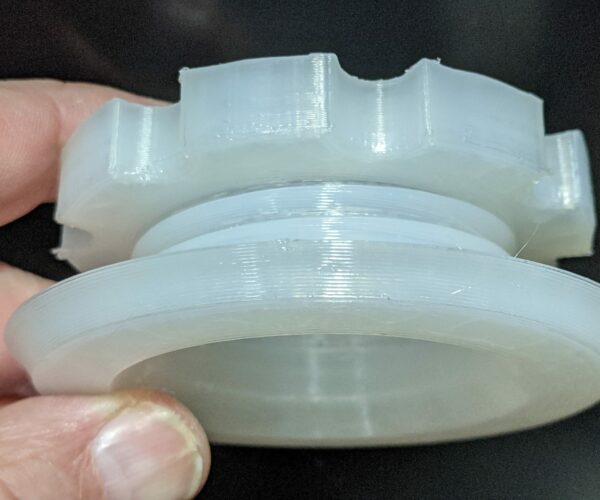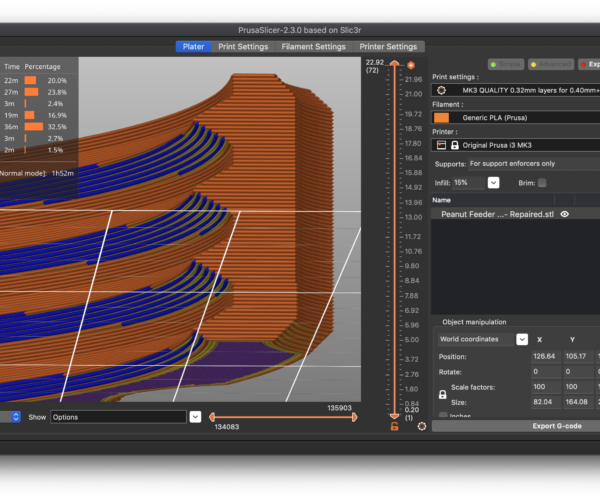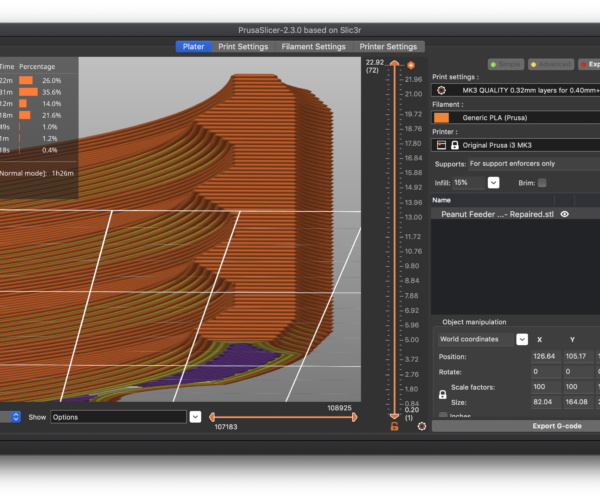maximum resolution/maximum deviation
I'm trying to change from Cura to PS. As with anything, there is a bit of learning. Is there an equivalent to the maximum resolution and maximum deviation setting in PS? If not, how do I deal with it in PS? My issue is trying to print threads; in Cura I needed to increase the resolution in order not to get layer separation. Any help would be appreciated. BTW, I'm still fairly new to 3D printing so that may be what is tripping me up. 😥
I don't know what those settings are in Cura as I don't use it but in PS under Print Settings>Advanced>Slicing there is a resolution setting. You must be in Expert mode to see it. Theres also slice gap closing radius in there that will merge faces with too small a gap between them. You have to be careful of that one when slicing tolerance tests as it can merge some of the closer ones if you aren't aware of the setting.
The 2.4 versions (which are in beta at the moment) also have some extra settings for slicing mode. Mainly to handle no manifold models like the RC plane wings or similar.
Threads aren't a problem with PrusaSlicer
Rather than spend time and effort trying to migrate settings over, many of which may have zero effect, I'd start with the default Prusa profiles and see how well they handle your prints. I found when migrating from Simplify 3D to Cura to PrusaSlicer that it was usually easier to start from scratch and concentrate on the settings that I knew made a difference. Slicers are different enough that no "universal translator" is going to create perfect results for one from another.
Here are the result I get with threads modeled in Fusion 360 with no manual tolerance adjustment...
printing with PLA
PETG
And Nylon
and miscellaneous other tech projects
He is intelligent, but not experienced. His pattern indicates two dimensional thinking. -- Spock in Star Trek: The Wrath of Khan
Exactly
@bobstro My thoughts exactly. Start with default settings and if there are any issues, work your way from there trying to map your knowledge from your previous slicer to PrusaSlicer as applicable. FWIW, I have printed multiple threaded things without any issue (with default settings). On a related note, one thing that can help create smoother threads is to reduce layer height to 0.15mm or lower. If you're printing small threads, lower is better.
Thanks for the replies
Interesting. I have tried using the default PS profile for the Ender 3 v2, but had the same problem. It is only the inside threads that where some of the perimeters don't stick and I end up with lines across in space. Outside thread work just fine. I did find that going to a lower layer hight does help but does not eliminate the problem. Maybe I need to play with it some more, probably I'm doing something to cause it, I'm just a rookie so that maybe is it.
Try wider extrusion widths along with lower layer heights
Interesting. I have tried using the default PS profile for the Ender 3 v2, but had the same problem. It is only the inside threads that where some of the perimeters don't stick and I end up with lines across in space. Outside thread work just fine. I did find that going to a lower layer hight does help but does not eliminate the problem.
The undersides are printed as extreme overhangs. If you have insufficient inter-layer adhesion, extrusions will pop loose and be pulled across. You can anticipate where this will happen by previewing the sliced print in PrusaSlicer:
The blue shows problem overhangs. As you've already noted, lower layer heights improve the ratio of width-to-height to improve adhesion, but there are limits. You can also use wider extrusion widths which provide more overlap between layers. Verify results in preview mode.
Finding the right balance should allow you to print threads successfully in most cases.
and miscellaneous other tech projects
He is intelligent, but not experienced. His pattern indicates two dimensional thinking. -- Spock in Star Trek: The Wrath of Khan
RE: Thanks bobstro
I will do some more experimenting. I never though about changing the line width, but it makes sense that more overlap will aid in the adhesion. 😀
Does the line width affect the dimensions/fit between the bolt and nut? Do I have to compensate if any?






